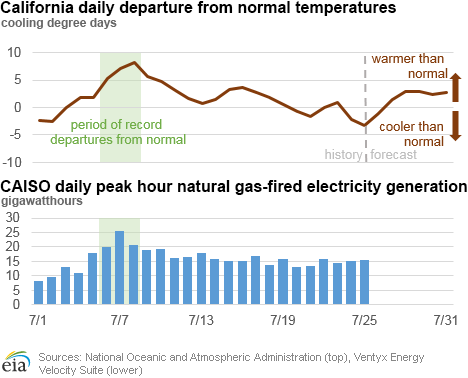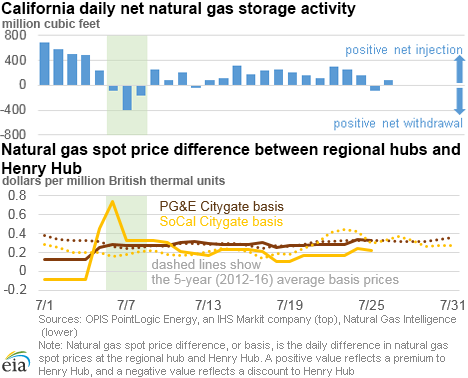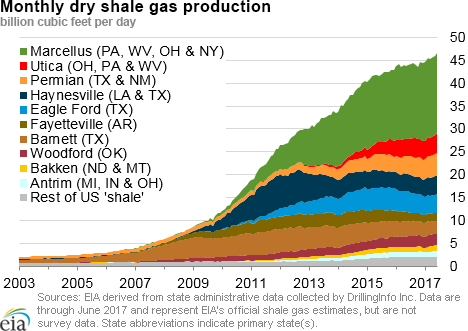In the News:
Record July temperatures in California coincide with price rise at regional natural gas trading hubs
California is on pace to have the warmest July since 2006, following a heat wave at the beginning of the month. From July 6–8, California tied or exceeded daily records going back to 1981 for measured cooling degree days (CDD), according to NOAA data. CDD can be used as an indicator of air conditioning requirements or use. Peak electricity generation from natural gas so far in July, 2017 was also highest over these same three days. Based on Ventyx Energy hourly data, natural gas-fired generation peaked at 25.4 gigawatt hours (GWh) on July 7 over the 7:00 p.m. hour, a time when solar power generation is reduced but demand for electricity is still relatively high.
Data from Bloomberg show that scheduled capacity for natural gas delivery to electric power plants—a proxy for anticipated demand for natural gas-fired power generation—exceeded the five-year (2012–16) maximums over July 6–10. However, scheduled capacity for natural gas deliveries to California power plants from July 1–21 is 270 million cubic feet per day (MMcf/d) lower than the five-year average for the same time period, even though the weather has been warmer. Contributing to this decrease is a steadily increasing share of solar power generation since 2012 and improved conditions for hydroelectric power generation in the first half of 2017. The share of natural gas-fired power generation in California’s energy mix has decreased to less than the 5-year averages.
According to data from PointLogic Energy, net injections of natural gas into storage in California in 2017 have totaled 4.7 billion cubic feet (Bcf) so far in July, which is 4 Bcf more than at this time last year, and 1.2 Bcf less than the five-year average. However, over the warmer-than-normal July 6–8 time period—when natural gas demand was elevated—California saw a net withdrawal of 0.7 Bcf. Net withdrawals from Lodi Gas storage facilities in Northern California totaled 0.5 Bcf over the three days, while PG&E—also in Northern California—had net injections of 0.3 Bcf over the same time period, according to PointLogic. Southern California Gas Company (SoCalGas) accounted for net withdrawals of 0.4 Bcf from July 6–8. SoCalGas inventories remain 8 Bcf (13%) lower than 2016 levels through July 22. Aliso Canyon, SoCalGas’s largest storage field, has had a moratorium on injections after a leak was detected in 2015. On July 19, the California Public Utilities Commission cleared the facility to resume limited activity to prevent energy shortages.
With cooler-than-normal temperatures, price differences at both SoCal Citygate and PG&E Citygate compared with the Henry Hub price started the month lower than their five-year averages. However, prices began to increase as the temperatures rose to higher than average near the end of the first full week of July. On July 6, prices for next-day delivery at SoCal Citygate in Southern California rose 74¢ higher than prices at the national benchmark Henry Hub, exceeding the five-year average price spread by 59¢. With more temperate weather in northern California and net injections at PG&E storage facilities, prices at PG&E Citygate were 28¢ more than at the Henry Hub, which is 2¢ higher than the five-year average price difference. As temperatures in California returned to the 15-year average, prices at SoCal Citygate and PG&E Citygate have been following their five-year averages. NOAA forecasts for California show CDD remaining close to average for the rest of July.
Overview:
(For the Week Ending Wednesday, July 26, 2017)
- Natural gas spot prices fell at most locations this report week (Wednesday, July 19 to Wednesday, July 26). The Henry Hub spot price fell from $3.10 per million British thermal units (MMBtu) last Wednesday to $2.92/MMBtu yesterday.
- At the New York Mercantile Exchange (Nymex), the August 2017 contract price fell 14¢ from $3.066/MMBtu last Wednesday to $2.924/MMBtu yesterday.
- Net injections to working gas totaled 17 billion cubic feet (Bcf) for the week ending July 21. Working natural gas stocks are 2,990 Bcf, which is 9% less than the year-ago level and 4% more than the five-year (2012–16) average for this week.
- The natural gas plant liquids composite price at Mont Belvieu, Texas, rose by 22¢, averaging $6.31/MMBtu for the week ending July 26. The price of natural gasoline, ethane, propane, butane, and isobutane all rose, by 1%, 1%, 4%, 7%, and 7%, respectively.
- According to Baker Hughes, for the week ending Friday, July 21, the natural gas rig count decreased by 1 to 186. The number of oil-directed rigs fell by 1 to 764. The total rig count decreased by 2, and it now stands at 950.
Prices/Supply/Demand:
Prices decreased at most points this week. This report week (Wednesday, July 19 to Wednesday, July 26), the Henry Hub spot price decreased 18¢ from $3.10/MMBtu last Wednesday to $2.92/MMBtu yesterday. At the Chicago Citygate, prices decreased 23¢ from $3.01/MMBtu last Wednesday to $2.78/MMBtu yesterday. Prices at PG&E Citygate in Northern California decreased 9¢, down from $3.37/MMBtu last Wednesday to $3.28/MMBtu yesterday.
The price at SoCal Citygate increased 2¢ from $3.20/MMBtu last Wednesday to $3.22/MMBtu yesterday. Temperatures in southern California were slightly warmer than average, creating cooling demand. Southern California Gas Company’s Aliso Canyon natural gas storage field is set to resume partial operation (not to inject above 23.6 Bcf), although no official start date has been announced.
Northeast prices fall sharply. At the Algonquin Citygate, which serves Boston-area consumers, prices went down $1.88 from $3.92/MMBtu last Wednesday to $2.04/MMBtu yesterday, reversing the $1.29 price increase the week prior. At the Transcontinental Pipeline Zone 6 trading point for New York, prices decreased $1.49 from $3.23/MMBtu last Wednesday to $1.74/MMBtu yesterday. Temperatures in the Northeast were close to the seasonal average, and demand for natural gas power generation was down for the region.
Tennessee Zone 4 Marcellus spot prices decreased 53¢ from $2.18/MMBtu last Wednesday to $1.65/MMBtu yesterday. Prices at Dominion South in northwest Pennsylvania decreased 60¢ from $2.24/MMBtu last Wednesday to $1.64/MMBtu yesterday.
Futures contract prices decrease. At the Nymex, the price of the August 2017 contract decreased 14¢, from $3.066/MMBtu last Wednesday to $2.924/MMBtu. The price of the 12-month strip averaging August 2017 through July 2018 futures contracts declined 10¢ to $3.006/MMBtu.
Supply remains flat. According to data from PointLogic Energy, the average total supply of natural gas remained the same as the previous report week, averaging 78.0 Billion cubic feet per day (Bcf/d). Dry natural gas production remained constant week over week. Average net imports from Canada decreased by 2% from last week.
Demand rises slightly. Total U.S. consumption of natural gas rose by 2% compared with the previous report week, according to data from PointLogic Energy. Natural gas consumed for power generation climbed by 5% week over week, exceeding 40 Bcf/d for three consecutive days from July 19 – 21, and the Henry Hub price averaged $3.07 during this peak according to PointLogic Energy data. Industrial sector consumption stayed constant, averaging 19.6 Bcf/d. In the residential and commercial sectors, consumption declined by 14%. Natural gas exports to Mexico remained constant.
U.S. liquefied natural gas (LNG) exports decline week over week. Three vessels (combined LNG-carrying capacity of 11.3 Bcf) departed Sabine Pass last week (Thursday to Wednesday).
Storage:
Weekly net injections are lower than the five-year average. Net injections into storage totaled 17 Bcf for the week ending July 21, compared with the five-year (2012–16) average net injection of 47 Bcf and last year's net injections of 20 Bcf during the same week. The smaller-than-average net injections this week likely resulted from the warmer-than-normal temperatures that prevailed throughout most of the Lower 48 states, increasing cooling demand for natural gas. This pattern was most pronounced in the South Central region, where warmer-than-normal temperatures resulted in net withdrawals from storage totaling 16 Bcf, compared with the five-year average net injection of 5 Bcf in the region. Working gas stocks total 2,990 Bcf, which is 111 Bcf more than the five-year average and 302 Bcf less than last year at this time.
Net withdrawals from storage are reported in the South Central region for the second week in a row. Net withdrawals from storage in the South Central region occurred at both salt and nonsalt facilities in the region. Withdrawals from salt facilities totaled 12 Bcf on the week and withdrawals from nonsalt facilities were 4 Bcf. Net withdrawals from storage have been reported at salt storage facilities during five of the last six report weeks. Prior to last week’s net withdrawal, storage operators in the South Central region reported net injections during 15 consecutive weeks since the start of the refill season.
So far in the 2017 refill season, net injections into working gas storage are lower than the five-year average in most regions of the Lower 48 states. Net injections into working gas are at 939 Bcf since March 31, 2017—the traditional beginning of the refill season—compared with the five-year average of 1,093 Bcf over the same period. Smaller-than-average net injections to date during the 2017 injection season are the result of high electric sector demand, which was coupled with warmer-than-normal temperatures on average; relatively high levels of natural gas exports; and storage levels that were already above average at the start of the refill season. The East and Mountain regions are the only regions where net injections have exceeded the five-year average. Cumulative net injections during the 2016 refill season in the Lower 48 states totaled 814 Bcf by this time last year, which was also characterized by unusually high storage levels at the start of the 2016 refill season.
The January 2018 futures price continues trading at a premium over the current spot price. During the most recent storage week, the average natural gas spot price at the Henry Hub was $3.05/MMBtu, while the Nymex futures price of natural gas for delivery in January 2018 averaged $3.37/MMBtu, a difference of 32¢. The premium was 56¢ a year ago. The average natural gas spot price at the Henry Hub was 1¢ higher than the front-month futures price at the Nymex. A year ago, the spot price was 4¢ higher than the front-month contract.
Reported net implied flows into storage are below the range of analysts’ expectations. According to The Desk survey of natural gas analysts, estimates of net injections to working natural gas storage ranged from 19 Bcf to 36 Bcf with a median of 24 Bcf. Prices of the Nymex futures contracts for August 2017 delivery at Henry Hub was relatively unchanged, decreasing 5¢/MMBtu to $2.98/MMBtu in 199 trades at the release of the Weekly Natural Gas Storage Report (WNGSR). The August 2017 contract is due to expire in trading today and the September contract will become the near-month contract. Prices on the futures contract for September delivery rose 4¢/MMBtu, to $2.97/MMBtu with 2,280 contracts traded at the release of the WNGSR. Prices for the September contract remained around that level in subsequent trading.
Temperatures were warmer than average in most parts of the Lower 48 states during the storage week. Temperatures in the Lower 48 states averaged 77 degrees Fahrenheit (°F), 2°F higher than the average and the same as last year at this time. Temperatures were warmer than average in parts of the South Central region, where natural gas-fired electricity generation for air conditioning plays a crucial role in summertime demand for natural gas. Temperatures in the East South Central Census division averaged 80°F, 1°F higher than the average and the same as last year at this time. Temperatures in the West South Central Census division averaged 84°F, 1°F higher than the average and 1°F lower than last year at this time.
See also:
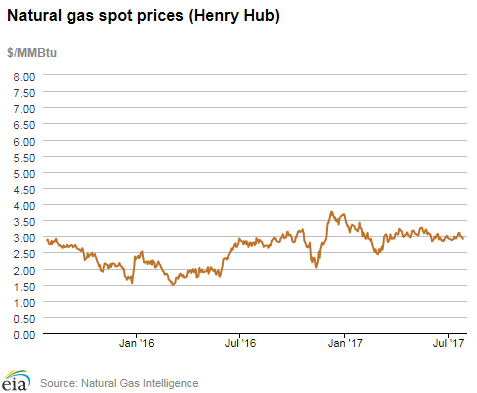
| Spot Prices ($/MMBtu) | Thu, 20-Jul |
Fri, 21-Jul |
Mon, 24-Jul |
Tue, 25-Jul |
Wed, 26-Jul |
|---|---|---|---|---|---|
| Henry Hub |
3.10 |
3.03 |
2.96 |
2.96 |
2.92 |
| New York |
3.14 |
2.66 |
2.20 |
2.08 |
1.74 |
| Chicago |
3.02 |
2.88 |
2.81 |
2.82 |
2.78 |
| Cal. Comp. Avg.* |
3.02 |
2.96 |
2.95 |
2.96 |
2.96 |
| Futures ($/MMBtu) | |||||
| August Contract | 3.043 |
2.970 |
2.899 |
2.944 |
2.924 |
| September Contract |
3.033 |
2.961 |
2.882 |
2.931 |
2.914 |
| *Avg. of NGI's reported prices for: Malin, PG&E Citygate, and Southern California Border Avg. | |||||
| Source: NGI's Daily Gas Price Index | |||||
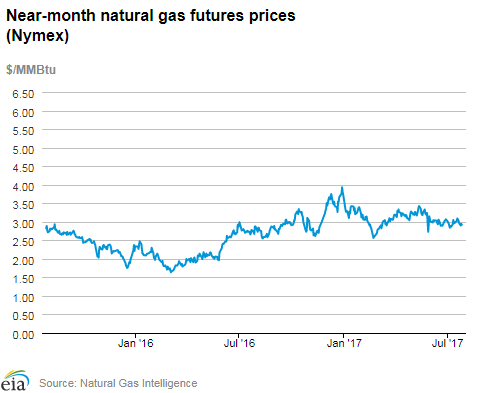
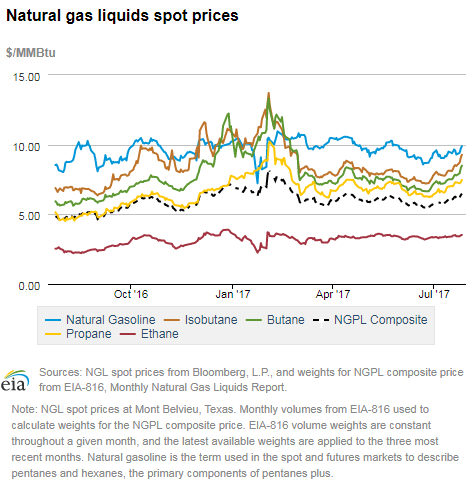
| U.S. natural gas supply - Gas Week: (7/20/17 - 7/26/17) | |||
|---|---|---|---|
Average daily values (Bcf/d): |
|||
this week |
last week |
last year |
|
| Marketed production | 81.0 |
81.2 |
79.3 |
| Dry production | 72.0 |
72.1 |
70.6 |
| Net Canada imports | 6.0 |
6.2 |
7.6 |
| LNG pipeline deliveries | 0.0 |
0.0 |
0.0 |
| Total supply | 78.0 |
78.3 |
78.2 |
|
Source: OPIS PointLogic Energy, an IHS Company | |||
| U.S. natural gas consumption - Gas Week: (7/20/17 - 7/26/17) | |||
|---|---|---|---|
Average daily values (Bcf/d): |
|||
this week |
last week |
last year |
|
| U.S. consumption | 62.0 |
61.0 |
65.6 |
| Power | 37.5 |
35.7 |
40.3 |
| Industrial | 19.7 |
19.7 |
19.5 |
| Residential/commercial | 4.8 |
5.7 |
5.8 |
| Mexico exports | 4.3 |
4.3 |
4.1 |
| Pipeline fuel use/losses | 6.7 |
6.6 |
7.1 |
| LNG pipeline receipts | 2.2 |
2.2 |
0.7 |
| Total demand | 75.1 |
74.1 |
77.4 |
|
Source: OPIS PointLogic Energy, an IHS Company | |||
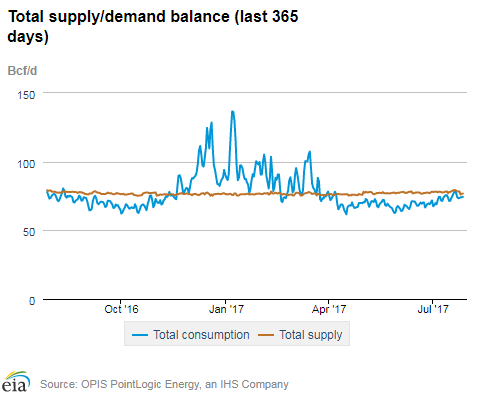
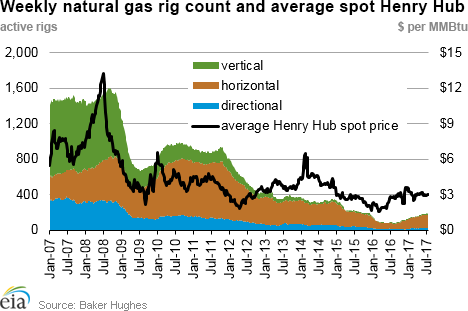
| Rigs | |||
|---|---|---|---|
Fri, July 21, 2017 |
Change from |
||
last week |
last year |
||
| Oil rigs | 764 |
-0.1% |
105.9% |
| Natural gas rigs | 186 |
-0.5% |
111.4% |
| Note: Excludes any miscellaneous rigs | |||
| Rig numbers by type | |||
|---|---|---|---|
Fri, July 21, 2017 |
Change from |
||
last week |
last year |
||
| Vertical | 72 |
-5.3% |
18.0% |
| Horizontal | 803 |
-0.1% |
124.9% |
| Directional | 75 |
4.2% |
70.5% |
| Source: Baker Hughes Inc. | |||
| Working gas in underground storage | ||||
|---|---|---|---|---|
Stocks billion cubic feet (Bcf) |
||||
| Region | 2017-07-21 |
2017-07-14 |
change |
|
| East | 626 |
609 |
17 |
|
| Midwest | 744 |
733 |
11 |
|
| Mountain | 197 |
194 |
3 |
|
| Pacific | 294 |
292 |
2 |
|
| South Central | 1,129 |
1,145 |
-16 |
|
| Total | 2,990 |
2,973 |
17 |
|
| Source: U.S. Energy Information Administration | ||||
| Working gas in underground storage | |||||
|---|---|---|---|---|---|
Historical comparisons |
|||||
Year ago (7/21/16) |
5-year average (2012-2016) |
||||
| Region | Stocks (Bcf) |
% change |
Stocks (Bcf) |
% change |
|
| East | 712 |
-12.1 |
661 |
-5.3 |
|
| Midwest | 813 |
-8.5 |
701 |
6.1 |
|
| Mountain | 213 |
-7.5 |
172 |
14.5 |
|
| Pacific | 318 |
-7.5 |
325 |
-9.5 |
|
| South Central | 1,236 |
-8.7 |
1,020 |
10.7 |
|
| Total | 3,292 |
-9.2 |
2,879 |
3.9 |
|
| Source: U.S. Energy Information Administration | |||||
| Temperature – heating & cooling degree days (week ending Jul 20) | ||||||||
|---|---|---|---|---|---|---|---|---|
HDD deviation from: |
CDD deviation from: |
|||||||
| Region | HDD Current |
normal |
last year |
CDD Current |
normal |
last year |
||
| New England | 4 |
3 |
4 |
57 |
14 |
-21 |
||
| Middle Atlantic | 0 |
-1 |
0 |
73 |
15 |
-13 |
||
| E N Central | 2 |
0 |
1 |
56 |
-1 |
-6 |
||
| W N Central | 1 |
-3 |
-1 |
85 |
13 |
19 |
||
| South Atlantic | 0 |
0 |
0 |
111 |
14 |
-5 |
||
| E S Central | 0 |
0 |
0 |
104 |
9 |
-4 |
||
| W S Central | 0 |
0 |
0 |
131 |
6 |
-7 |
||
| Mountain | 0 |
-4 |
-1 |
92 |
13 |
1 |
||
| Pacific | 1 |
-3 |
-1 |
68 |
25 |
19 |
||
| United States | 1 |
-1 |
0 |
86 |
12 |
-2 |
||
|
Note: HDD = heating degree day; CDD = cooling degree day Source: National Oceanic and Atmospheric Administration | ||||||||
Average temperature (°F)
7-Day Mean ending Jul 20, 2017
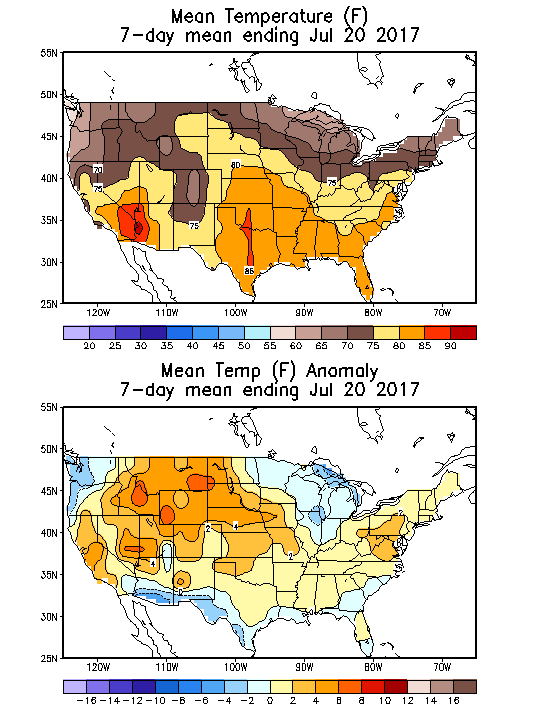
Source: NOAA National Weather Service
Deviation between average and normal (°F)
7-Day Mean ending Jul 20, 2017

Source: NOAA National Weather Service

